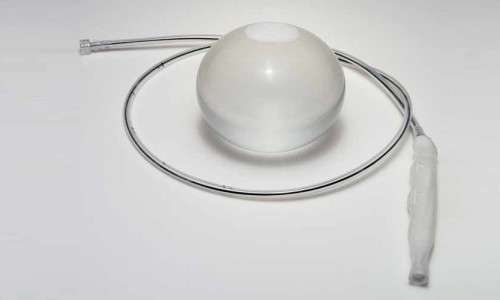Both Gastric Ballooning as well as Gastric Banding are designed to help people lose weight in conjunction with healthy modifications in diet and lifestyle.
Adjustable gastric banding is a surgical option. It’s a type of bariatric surgery. With gastric banding, also called a lap band, an inflatable band is surgically placed around the stomach. This creates a small pouch in the upper part of the stomach which limits the amount of food a person can eat at one time. Gastric banding is generally performed as laparoscopic surgery, and is considered the least invasive form of bariatric surgery. However, it is still surgery and comes with all the risks of major surgery as well as the recovery time. In addition, some patients are not eligible for the laparoscopic procedure and need to undergo an incision in order to get the adjustable gastric band put in place.
The Spatz3 Adjustable Balloon is a medical grade balloon, filled with saline that rests in the stomach cavity and occupies approximately a third of the stomach volume that causes a decrease in appetite. In addition, with the gastric balloon in place, the stomach empties relatively slowly, so you have a feeling of fullness for longer period of time. The adjustable gastric balloon does not require surgery. It is inserted during a routine, out-patient procedure known as an endoscopy.
To be eligible for an adjustable gastric band, you either need a BMI of 40 or above or a BMI of 30 and above with at least one serious health issue that can improve with weight loss, such as high blood pressure, diabetes, osteoarthritis, sleep apnea, gastric reflux or metabolic syndrome.
The requirements for an adjustable gastric balloon are lower. You need a BMI of 27 or above and you don’t necessarily have to suffer from any related conditions.
Adjustable gastric balloons may also used for people who are not suitable candidates for weight loss surgery. The use of the gastric balloon may be used to reduce weight prior to any surgery, therefore reducing the risks associated with surgical procedures. The Spatz3 Adjustable Gastric Balloon is an ideal, non-invasive alternative to gastric bypass surgery, lap band surgery and other bariatric surgeries.
How is the gastric balloon placed in to the stomach?
How Long Is The Procedure?
Placement of the balloon takes approximately 20 minutes, after which patients are monitored by nursing staff in the recovery bay. As this is a “day-only” procedure, patients are generally discharged within two hours after balloon insertion.
Who Is A Good Candidate For Gastric Ballooning?
The intra-gastric balloon is designed to assist with weight loss in people who ideally have 10 to 30 kilograms of weight to lose. You need a BMI of 27 or above to be a good candidate for gastric ballooning.
It is also used for people who are not suitable for other forms of weight loss surgery. The use of the Gastric Balloon may assist in reducing weight prior to surgery, therefore reducing the risks associated with surgical procedures on overweight patients.
How long the gastric balloon stays in the stomach cavity?
The Gastric Balloon can be placed in the stomach for a six-month period. If the doctor recommends a period, longer than 6 months, it is necessary to replace the balloon with a new one after 6 months.
How the removal of gastric balloon is done on completion of 6 months period?
The gastric balloon is removed in the same way as it was placed, via the oesophagus and mouth. Using an endoscopic camera, the physician introduces a catheter through the mouth into the stomach. The balloon is then punctured and deflated. Once the balloon is deflated it can be pulled out.
How much weight can a patient lose with the intragastric balloon?
Intra-gastric balloon is a tool to aid weight loss and must be used in conjunction with diet, exercise and a behavior modification program. The amount of weight you lose and maintain, will depend on how closely you follow your diet plan provided by your doctor and adopt long-term lifestyle changes.
What feeling I will get on placement of a gastric balloon in my stomach?
There will be discomfort during the first few days after the placement. From then on, the gastric balloon will give you a feeling of fullness.
What is the recovery time after the procedure?
You should plan at least three days of inactivity to recover from the procedure. You will be able to resume normal activity sooner or later than this depending on how quickly your body adjusts to the balloon.
Does the gastric balloon require frequent post-procedure visits to doctor?
The follow-up program is critical to success of the gastric ballooning and in learning new lifestyle skills. You will meet with your lifestyle team at least once a month, during the first six months while the balloon is in place and then bi-monthly, once the balloon is removed, for an additional six months. During this time your progress will be evaluated and you will learn valuable principles of health, nutrition and exercise that will provide you a foundation for long-term success.
Will the gastric ballooning effect my activities?
During the first week of the procedure you should not plan any heavy activities. Once your body has adjusted to the balloon you can resume your normal activities. Starting a regular exercise program is highly recommended and will improve your success.
Can I eat anything I want?
There are no food restrictions, although you will not feel like eating as much as you used to. In addition, if you eat fatty foods or sweets, you may feel unwell. Excessive overeating while the balloon is in place can prove dangerous.

